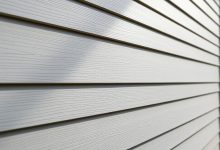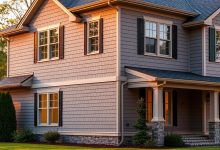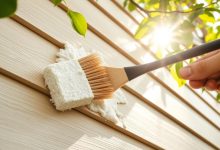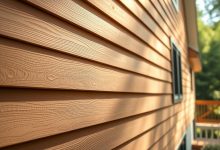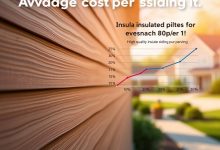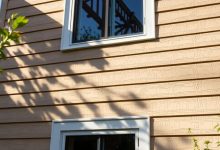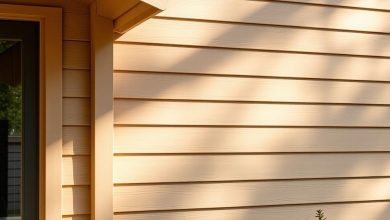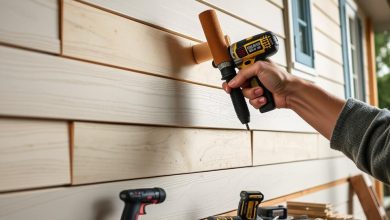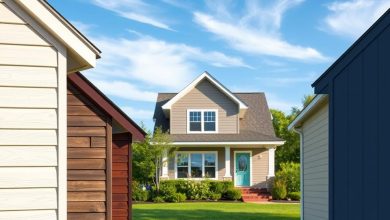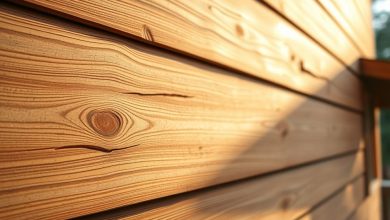Insulated Siding: Boost Home Insulation Efficiency
As homeowners, we’re always searching for ways to improve our home’s energy efficiency and cut down on energy costs. Installing insulated siding is a smart choice. It not only makes your home look better but also protects it from the weather.
Insulated siding adds insulation to your home’s outside. This helps keep your home warm in winter and cool in summer. Your home becomes more energy-efficient, saving you money on heating and cooling.
Key Takeaways
- Improve your home’s energy efficiency with insulated siding
- Reduce energy costs with a robust insulation barrier
- Enhance your home’s exterior with a modern, sleek design
- Increase your home’s value with this desirable feature
- Enjoy a more comfortable living space with reduced temperature fluctuations
Understanding Insulated Siding Basics
Insulated siding is key for energy-efficient homes. It’s not just for looks; it also saves energy. This makes homes more comfortable and cost-effective.
What Is Insulated Siding?
Insulated siding combines siding with insulation. This mix boosts the R-value. It helps keep your home cooler in summer and warmer in winter.
How Insulated Siding Works
It stops heat from escaping in cold weather and entering in hot weather. Its layers include insulation. This design is effective.
Core Components and Structure
Insulated siding has three main parts: the siding, insulation, and sometimes a weather-resistant layer. Vinyl, fiber cement, and engineered wood are common materials used.
| Siding Material | Insulation Type | R-Value |
|---|---|---|
| Vinyl | Foam Backer | 3-5 |
| Fiber Cement | Insulated Backing | 4-6 |
| Engineered Wood | Integrated Insulation | 5-7 |
The Science Behind Insulated Siding for Better Insulation
Insulated siding works by blocking outside temperatures. This keeps your home warm in winter and cool in summer. It’s a key part of keeping your home energy-efficient.
R-Value Explained
The R-value shows how well a material stops heat. Insulated siding has a high R-value, making it better at insulation. A higher R-value means better insulation.
Thermal Bridging Prevention
Thermal bridging happens when heat escapes through siding gaps. Insulated siding stops this, keeping your home’s temperature steady. This leads to less energy use.
Moisture Management Properties
Good moisture management stops siding and home damage. Insulated siding has features like drainage and mold-resistant materials. This keeps your home dry and safe.
Insulated siding offers many benefits:
- Improved energy efficiency
- Reduced thermal bridging
- Enhanced moisture management
It’s a complete solution for better home insulation and lower energy bills.
Types of Insulated Siding Materials
The market offers a wide range of insulated siding materials. They cater to different needs and preferences of homeowners.
Vinyl Insulated Siding
Vinyl insulated siding is a favorite due to its affordable cost and low maintenance requirements. It has insulation sandwiched between vinyl siding and a backing. This siding helps reduce energy costs and improve indoor comfort.
Fiber Cement Insulated Options
Fiber cement insulated siding is durable and resists pests and weathering. It’s made of cement, sand, and cellulose fibers. This material is strong and lasts long. It can be painted to fit any exterior design.
Engineered Wood with Insulation
Engineered wood siding with insulation is eco-friendly. It offers a natural look while keeping energy costs down. Made from wood fibers, it’s dense and insulated. This siding is known for its thermal performance and aesthetic appeal.
Foam Backing Variations
Foam backing is common in insulated siding, adding extra insulation. It can be made from expanded polystyrene (EPS) or extruded polystyrene (XPS). This boosts the siding’s thermal performance.
Comparing these materials helps homeowners make informed choices. Here’s a table summarizing each material’s key characteristics:
| Material | Cost | Durability | Maintenance | Energy Efficiency |
|---|---|---|---|---|
| Vinyl Insulated Siding | Low | Medium | Low | High |
| Fiber Cement Insulated Siding | Medium | High | Medium | High |
| Engineered Wood with Insulation | High | Medium | Medium | High |
| Foam Backing Variations | Varies | Varies | Varies | High |
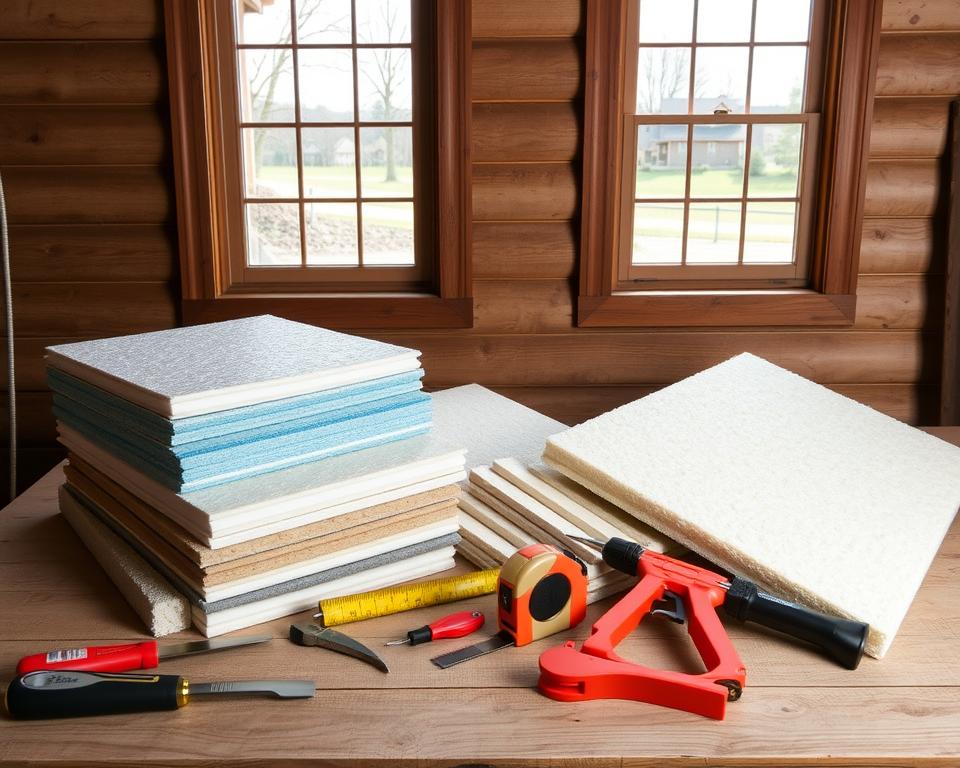
Key Benefits of Installing Insulated Siding
Insulated siding is a smart choice for homeowners. It saves energy and makes your home more comfortable. It also reduces noise and strengthens your home’s structure.
Energy Cost Savings
Insulated siding cuts down on energy costs. It keeps your home warm in winter and cool in summer. This can save you a lot on your heating and cooling bills.
According to the U.S. Department of Energy, good insulation can cut energy bills by up to 30%. Insulated siding helps by stopping heat loss and keeping your home at a steady temperature.
Improved Indoor Comfort
Insulated siding makes your home more comfortable. It keeps the temperature even, so you don’t feel cold spots. It also helps control humidity, making your home feel even cozier.
“The right siding can make a huge difference in how comfortable your home feels. Insulated siding is a game-changer.” –
Noise Reduction Properties
Insulated siding also reduces outside noise. The extra insulation blocks out sounds, making your home quieter. This is great for homes near busy streets or highways.
Structural Reinforcement
Insulated siding also makes your home stronger. The foam insulation adds durability, helping your home stand up to weather. This might even mean fewer repairs in the future.
| Benefit | Description |
|---|---|
| Energy Cost Savings | Reduces heat loss and gain, lowering energy bills |
| Improved Indoor Comfort | Maintains consistent temperatures and reduces drafts |
| Noise Reduction | Acts as a barrier to external noise |
| Structural Reinforcement | Adds strength and durability to the home’s exterior |
Aesthetic Considerations and Design Options
Insulated siding lets homeowners mix style with function. It comes in many styles, textures, and colors. This makes it easy to match your home’s look.
Available Styles and Textures
Insulated siding has different styles like wood, vinyl, and fiber cement. Each style looks and feels unique. This lets homeowners pick the best fit for their home’s outside.
Wood-style siding gives a natural vibe. Vinyl siding, on the other hand, offers a modern, sleek look.
Color Options and Customization
Insulated siding comes in many colors, from calm tones to bold ones. Homeowners can pick a color that matches their home or try something new.
Some makers offer custom color matching. This lets homeowners match their siding to their home’s colors perfectly.
Architectural Compatibility
Insulated siding fits many architectural styles, from modern to traditional. It works well with both contemporary and classic homes. There’s a siding option for every design.
| Architectural Style | Recommended Insulated Siding Style | Key Features |
|---|---|---|
| Modern | Vinyl or Fiber Cement | Sleek lines, minimal texture |
| Traditional | Wood or Wood-look | Classic look, textured finish |
| Colonial | Clapboard or Beaded | Classic profile, subtle texture |
Installation Process and Considerations
The success of insulated siding depends a lot on how it’s installed. A good installation means the siding works well, saving energy and looking great.
Professional vs. DIY Installation
Many homeowners wonder if they should get professional installation or do it themselves. DIY can save money, but it needs a lot of skill and the right tools. Professionals ensure a top-notch job and offer warranties.
Preparation Requirements
Before putting on insulated siding, the home’s exterior needs to be ready. This means checking and fixing any damaged sheathing, making sure walls are straight, and removing old siding.
Common Installation Challenges
Installers might run into issues like uneven walls, tricky spots around windows and doors, and keeping moisture out.
Timeline and Seasonal Considerations
The installation timeline can change based on the project’s size and the weather. It’s best to avoid bad weather, like heavy rain or too much heat, when installing siding.
Cost Analysis of Insulated Siding
Insulated siding has both immediate and long-term financial effects. Homeowners need to look at the upfront cost, long-term savings, financing choices, and tax benefits. They also need to think about when they’ll see a return on their investment.
Initial Investment Breakdown
The cost of insulated siding includes the price of materials, installation, and extra expenses. Material costs can vary widely depending on the type of insulated siding chosen, with options ranging from vinyl to fiber cement. Installation costs also vary based on the complexity of the job and the installer’s rates.
For example, homeowners might spend between $8 to $12 per square foot. This means a typical home could cost between $8,000 to $24,000 or more. This depends on the home’s size and the materials used.
Long-Term Savings Calculation
Insulated siding can save a lot of money in the long run, mainly through lower energy bills. By improving a home’s insulation, homeowners can cut their heating and cooling costs. The U.S. Department of Energy says some homeowners could save $200 to $500 or more each year. This depends on the climate and the siding’s efficiency.
Financing Options and Tax Incentives
There are many financing options for insulated siding, like loans and credit programs. Some homeowners may also be eligible for tax incentives, such as tax credits or deductions. This is often the case if the siding is part of a larger energy-efficient renovation project.
Return on Investment Timeframe
The timeframe for the return on investment (ROI) for insulated siding varies. It depends on the siding’s cost, energy savings, and local energy costs.
“Insulated siding can pay for itself through energy savings within 10 to 15 years or more, depending on the circumstances.”
Homeowners should calculate their specific ROI. This will help them understand when the siding will pay for itself.
Comparing Insulated Siding to Traditional Insulation Methods
Insulated siding is a new option for homeowners wanting to save energy. It’s a different way to make homes more energy-efficient.
Insulated Siding vs. Traditional Siding with Separate Insulation
Traditional siding needs insulation added separately. Then, siding goes on top. Insulated siding combines both into one, making it easier to install.
Key differences include:
- Simplified installation process
- Potential for reduced labor costs
- Integrated insulation that may offer better thermal performance
Performance in Different Climate Zones
Insulated siding works differently in various climates. In cold areas, it keeps more heat in. In warm areas, it keeps the home cooler.
A study by the insulation research group found that insulated siding can reduce energy consumption by up to 15% in certain climates.
| Climate Zone | Traditional Insulation | Insulated Siding |
|---|---|---|
| Cold | Good insulation | Excellent insulation |
| Temperate | Moderate energy savings | Good energy savings |
| Hot | Reduced heat gain | Significant reduction in heat gain |
Integration with Existing Home Insulation
Insulated siding can work with your home’s current insulation. It adds an extra layer to keep your home more comfortable.
“Insulated siding is a game-changer for homeowners. It not only improves the aesthetic appeal of the home but also significantly enhances its energy efficiency.”
Case Studies and Real-World Performance
Many studies show insulated siding’s benefits. For example, a U.S. study found homes with it saved 12% on energy compared to traditional setups.
Maintenance and Longevity of Insulated Siding
To keep insulated siding working well, homeowners need to know how to care for it. Taking good care of it boosts its durability and keeps it energy-efficient.
Cleaning and Care Guidelines
Cleaning the siding regularly is key to stop dirt and debris buildup. Use a soft-bristled brush or a low-pressure washer for cleaning. Stay away from harsh chemicals and high-pressure washes, as they can harm the siding and reduce its insulation.
- Check the siding every year for damage or wear.
- Clean the siding once a year, or more if you live in a polluted area or near trees that drop a lot of leaves.
Durability and Lifespan Expectations
Insulated siding is very durable and can last 20 to 50 years or more. The exact lifespan depends on the material and how well it’s maintained. Vinyl insulated siding, for example, can last up to 30 years with proper care.
“The durability of insulated siding makes it a cost-effective option in the long run.” –
Repair and Replacement Considerations
Even though insulated siding is durable, it can get damaged by extreme weather or accidents. It’s important to fix issues quickly. For small damages, repairs are easy, but big problems might need a professional to replace it.
Regular inspections can catch problems early, before they get big.
Seasonal Performance and Weather Resistance
Insulated siding works well in different climates, keeping your home warm in winter and cool in summer. But, extreme weather can affect it. For example, too much sunlight can cause fading, and heavy snow can stress the siding.
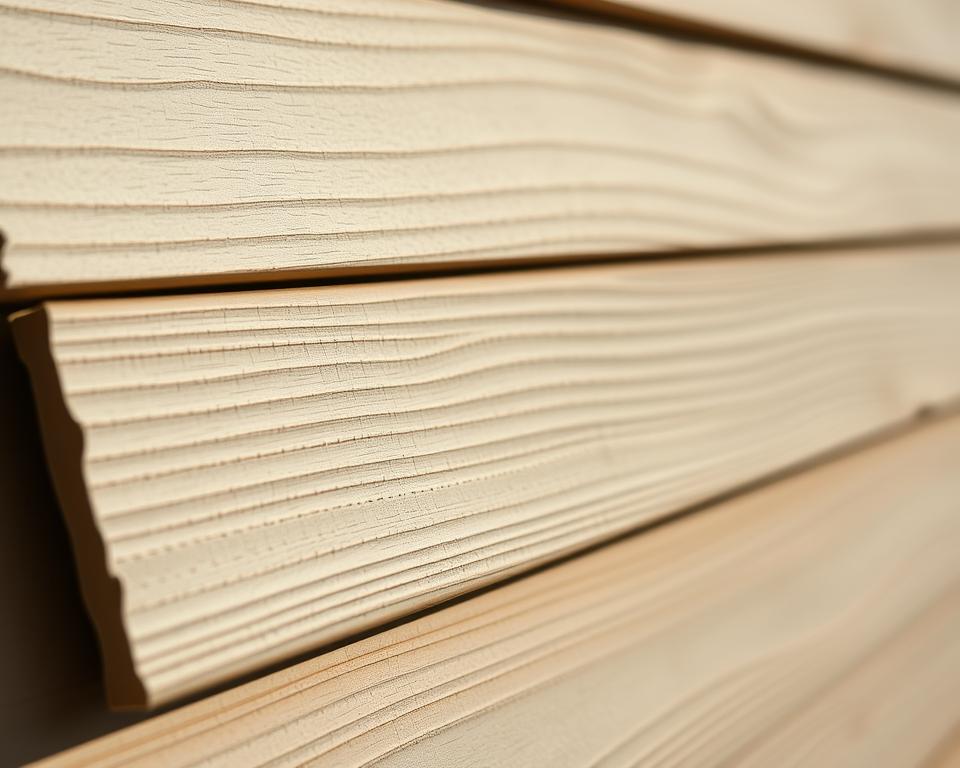
Knowing how to maintain your siding can help it last longer and work better.
Conclusion: Is Insulated Siding Right for Your Home?
Insulated siding brings many benefits, like saving on energy costs and making your home more comfortable. It also helps reduce noise. By learning about its basics, types, and how to install it, you can decide if it’s right for your home.
Thinking about getting insulated siding? You should compare the upfront cost to the long-term savings and any downsides. Things like your home’s climate, insulation, and style are key in deciding if it’s a good fit.
Choosing insulated siding should be a careful thought. It’s about matching your home’s needs and your own preferences. This way, you get better energy use, more comfort, and a greener home. Before making a final decision, talk to experts for a smooth installation and the best results.
